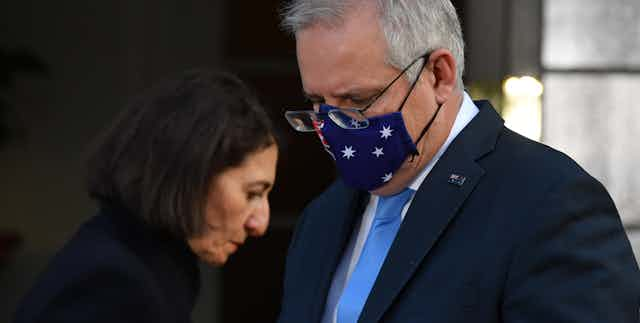The economic support package announced by Prime Minister Scott Morrison and NSW Premier Gladys Berejiklian is exactly what is needed, and just in the nick of time.
In a number of ways, in fact, it is more fit for purpose than the JobKeeper and JobSeeker policies that played such a key role in shielding the nation from the worst economic impacts of the COVID-19 pandemic.
There is support for workers who lose their jobs or have their hours cut, and incentives for affected businesses to keep their workers on the payroll.
In the face of what looks set to be an extended lockdown for Sydney, significant support was clearly needed. The federal government has rightly resisted calls to reinstate the JobKeeper wage subsidy, and opted instead for a new, more flexible scheme better suited to the circumstances.
There are two key planks of support, working together.
Read more: Yes, lockdowns are costly. But the alternatives are worse
Payments to individuals
The first is payments for individuals. For Melbourne’s lockdown in late May and early June the federal government provided up to A$500 a week to those losing more than 20 hours of work a week. It is boosting this to $600 a week. For those losing eight to 20 hours a week, the payment is increasing from $325 to $375. The liquid assets test that applied to the Victorian payments has been scrapped.
Critically, any worker who loses enough hours is eligible. That means the payment can help virtually all workers losing work due to the lockdown, at least to some degree, and gives businesses the flexibility to scale down by reducing hours while minimising the impact on workers. We can squabble about the generosity of the payment, but it is more than double the rate of JobSeeker.
Importantly, it means the cost of the lockdown is being shared by the federal and state governments, rather than just falling on businesses and workers. This provides confidence that lockdown decisions will be made entirely in accordance with the public health advice.
Payments to businesses
The second plank is a partnership between the federal and state governments to revive the cash-flow boost instituted at the beginning of the pandemic, before the federal government introduced JobKeeper.
Only businesses with annual turnover between $75,000 and $50 million are eligible. For those suffering a 30% decline in annual turnover (compared to pre-pandemic times), the payment will cover 40% of their payroll costs up to a maximum of $10,000 a week. To qualify, however, they must not lay off any staff.
This emulates one of the best features of JobKeeper by maintaining the connection between employers and employees through the crisis to speed the recovery once restrictions lift.
Read more: Why most economists continue to back lockdowns
Improvements on JobKeeper
In his press conference, the Prime Minister described the measures as targeted, timely, proportionate, scalable and able to be administered quickly and simply.
It’s hard to disagree.
One aspect that’s a big improvement over JobKeeper is that the turnover test is based on actual turnover, rather than projected turnover or trailing turnover, as with the earlier schemes. This should see the money better targeted to the businesses genuinely in need.
Another improvement is that it drops the cumbersome JobKeeper approach of paying employers a per-employee subsidy they were then expected to pass on to each worker at a fixed rate regardless of actual hours. This time businesses will get a payroll subsidy they can use however they see fit — so long as they don’t lay anyone off.
This should maximise flexibility, and minimise business failures and layoffs. And compliance should be straightforward to enforce via Business Activity Statements and Single Touch Payroll records.
But it is all a bit reactive
I do, however, see one negative.
Just as many ordinary Australians seem to have assumed and behaved as though the pandemic was behind us, so did the federal government in configuring its fiscal support measures earlier this year.
It was right to end the JobSeeker supplement and JobKeeper as the economy recovered. But it was wrong not to replace them with a suite of more flexible, contingent measures to be triggered in the event of future lockdowns. It should have foreseen the possibility of a future prolonged lockdown and been prepared for it, rather than be forced to play catch-up.
Following the announcement of these measures, the federal minister for government services, Linda Reynolds, said “our response will continue to evolve”. But what businesses and consumers have needed all along is certainty — to know that if things go pear-shaped there’s a plan and they will be looked after.
Without that certainty, consumers will hold back on spending and businesses will hold back on investment, putting a brake on the economic recovery.
Every Australian consumer, worker and business — in every Australian state and territory — needs to know today exactly how they’ll be supported should things get a lot worse or go on a lot longer than currently expected.

